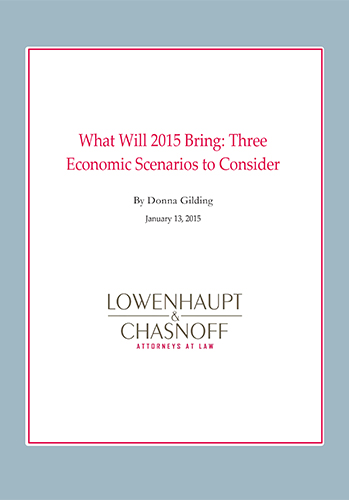What Will 2015 Bring: Three Economic Scenarios to Consider
By Donna Gilding
2014 turned out to be a notable year for a number of reasons even excluding geopolitical risks and global financial crises:
-
-
- Small cap stocks had a great December and fourth quarter – up 2.97% and 10.06% respectively
- REITS and long Treasuries were the best performers for the quarter – up 14.35% and 8.62%
- REITS and long Treasuries led the markets for the twelve-month period – up 30.26% and 25.07%
- We did not see a lot of folks betting on either REITS or long bonds of any flavor.
-
2014 is the sixth year with positive returns, the third year of double-digit returns and the 4th longest bull market in post-war history.
There was also a large spread (8.03%) between the MSCI All-Country World index (4.16%) and the negative return (- 3.87%) for the MSCI All-Country ex USA. Spreads were wide between large and small stocks but relatively narrow across the size spectrum between value and growth.
Where Do We Go From Here?
In many ways, we are programmed to view life and investments on a year-by-year basis. We need to continue to remind ourselves that our lives and investment programs do not start over annually, but both should have a long-term focus.
The world economy and capital markets are somewhat detached from one another. The US is recovering; consumer confidence is at 2007 levels; money is flowing back into equity funds. The week before Christmas, according to Lipper, saw the biggest influx into equity funds since 2007. And, the economy is growing at its fastest rate since 2005.
The rest of the world is in varying degrees of distress. The European Central Bank is worried about deflation in Europe. Spanish bond yields are at all-time lows of about 1.5%. Emerging markets, particularly EMEA and Latin America, saw negative performance of 15.18% and 12.30% respectively.
A number of our managers expect that over the next 10 years the emerging markets will outperform the US. They have high savings rates, educated populations and are willing to make the adjustments necessary to succeed. The emerging markets look cheap now and the US looks very expensive. These managers are not suggesting that broad changes be made to current asset allocations, but that diversification, including emerging markets, is critical going forward to protect against extremes.
Three Possible Scenarios for 2015
Our managers know it is important to be planning beyond just twelve months. In the interim, there are a number of scenarios that could play out over the next twelve months. 
In one scenario, US corporate sales would improve, wages remain controlled and cheap oil would help to keep margins high. With a strong dollar and inflation essentially non-existent, the Fed might delay rate hikes. In addition, easy money from the ECB and China, along with inexpensive oil, should ease problems in those countries. Should their stock markets ramp up, we could see profit-taking and funds flowing to the US as a safe haven, as we witnessed at 2014 year-end. This scenario has the potential to create another bubble in the US markets where valuations are already stretched.
In another, more likely scenario, US growth takes off, the Fed raises rates and the dollar strengthens. Oil remains cheap, wages rise and consumers start to spend again. However, it is not all good news. The strong dollar weakens overseas earnings. That possibility could create a trade deficit and a drop in the current account surplus, thus making US goods and services more expensive and less attractive to other countries.
A third scenario could lead us to a number of different crises. Russia, a commodity-driven economy, could lapse into a recession. A downturn could send funds flowing out of Russia and other emerging markets and into the US, a safe haven. The flight to safety could precipitate a sudden drop in US stock prices, like we saw in October. Another potential crisis could be the economy in China slowing sufficiently to cause the shadow banking system to fail.
These are just three potential scenarios. Which one occurs is anyone’s guess. An important variable is what the Fed might do. Based on recent statements by the Federal Reserve Chairman Janet Yellen, it appears that quantitative guidance will be missing from the Chairman’s future statements. Were the Fed to defer a rate hike, however, a full-blown crisis appears less likely.
 Yet another variable is the price of oil. Most managers think that, while the price could fluctuate a bit, the $50 to $60 +/- per barrel is a sweet spot. Were it to fall much more, a crisis would ensue. Should it rise significantly, growth would be hampered.
Yet another variable is the price of oil. Most managers think that, while the price could fluctuate a bit, the $50 to $60 +/- per barrel is a sweet spot. Were it to fall much more, a crisis would ensue. Should it rise significantly, growth would be hampered.
For now, we should watch for economic data and fourth quarter earnings for any sign of weakness. Stagnant revenue or tighter margins could be worrisome. When managers asked what they thought would cause a major crisis, the answer was: “Watch the politicians.”

